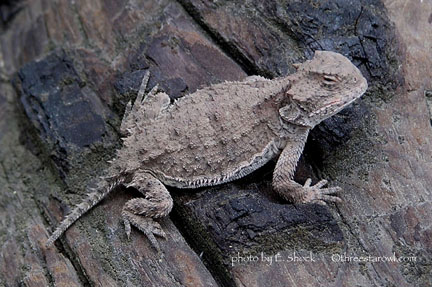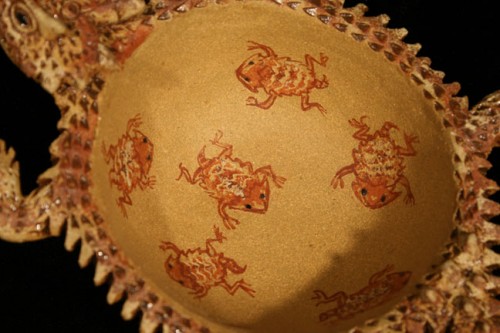A Bowl of Horned Lizards
About horned lizards
Though sometimes called “horny toads” these reptiles are not toads at all but flat, round lizards which inhabit dry open areas of the western US and Mexico. They are especially well-armored with keeled scales, knobs, and yes, horns, making them look like little dragons. But they feel surprisingly soft when you pick one up, not unlike a beaded purse. (The grumpy-looking guy in the photo below is a Greater short-horned lizard E and I found trying to bask on a cloudy day on a ponderosa log on a backpacking trip in the Gila Wilderness of western New Mexico.)
Failing camouflage and flight, their ultimate defense from harassment is to shoot blood from their eyes. This isn’t an old wives’ tale like bats getting snarled in long hair — they really do it. It works pretty well, often startling the lizard’s captor into dropping it.
Horned lizards favor ants, especially of the genus Pogonomyrmex, Harvester ants, which comprise a generous portion of their food intake.
Most horned lizards lay eggs, but species like Short-horned which live at higher altitudes where the breeding season is too short to incubate eggs, give birth to live young — from 5 to 48 at a time!
These amazing animals have a specialized solar receptor under a clear scale on the top of the head. It’s called the pineal gland, and it’s linked directly to the brain. Although its function is not fully understood, it plays a role in the regulation of body temperature. The pineal gland has many features similar to the structure of an eye, though it is not linked to the optic nerve. Look for the small pineal gland on a Three Star Owl horned lizard bowl, indicated subtly on the top of the skull between the eyes.
Herpetologists currently recognize 13 species of Horned lizards, 8 in the US and 5 in Mexico.
My favorite horned lizard resource is the book Introduction to horned lizards of North America, by Wade E. Sherbrooke, UC Press 2003.
Horned lizard bowls from Allison Shock and Three Star Owl
I’m currently making horned lizard bowls representing two species, both native to Arizona and other parts of the Southwest: Short-horned lizards and Regal horned lizards. You can tell them apart by their horn configuration: Regals have an even corona of ten longish horns on the back of their skull, and Short-horns have 6 very short horns divided by a deep notch.
 Both eat ants, so I depict Harvester ants in their bellies. The Short-horned is a live-bearer, so some have young lizards shown inside.
Both eat ants, so I depict Harvester ants in their bellies. The Short-horned is a live-bearer, so some have young lizards shown inside.
These bowls are handmade from stoneware, and fired to cone 5. Each bowl is different, and each scale is done individually by hand, as is the slip-painting in their bellies. There is no glaze on these pieces, but the mineral-pigmented slips are fired in place, and are indelible. Because of the lack of glaze, I don’t recommend them for frequent food use, or storing liquids. Primarily they are meant to be gazed at adoringly. Click here to see a picture of Horned lizard bowls on threestarowl.com.

Hi Allison,
I contacted you some time ago about a horned toad bowl. I am now ready to purchase one of the short-horned with babies. I am looking for a smaller one. Do you currently have any available?
Thanks!
Joan